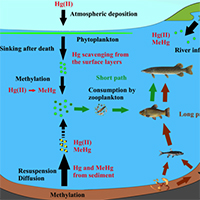Mercury methylation in oxic aquatic macro-environments: a review

Accepted: 27 February 2021
HTML: 106
All claims expressed in this article are solely those of the authors and do not necessarily represent those of their affiliated organizations, or those of the publisher, the editors and the reviewers. Any product that may be evaluated in this article or claim that may be made by its manufacturer is not guaranteed or endorsed by the publisher.
Authors
Mercury methylation in aquatic environments is a key process that incorporates this neurotoxin into the food chain and ultimately the human diet. Mercury methylation is considered to be essentially biotic and mainly driven by sulfate-reducing bacteria present in the bottom sediments in aquatic systems. However, in recent decades, many researchers have shown that this methylation also occurs in oxic layers in conjunction with a high content of particulate organic matter and localized depletion of dissolved oxygen. The goals of this review are to summarize our current understanding of Hg methylation in water columns of both marine and freshwater environments, as well as to highlight knowledge gaps and future research needs. Most of the literature showed that suspended particles (known as marine and lake snow) could be the microenvironment in which Hg methylation could occur across oxic water columns, because they have been recognized as a site of organic matter mineralization and as presenting oxygen gradients around and inside them. To date, the majority of these studies concern marine environments, highlighting the need for more studies in freshwater environments, particularly lacustrine systems. Investigating this new methylmercury production environment is essential for a better understanding of methylmercury incorporation into the trophic chain. In this review, we also propose a model which attempts to highlight the relative importance of a MeHg epilimnetic path over a MeHg benthic-hypolimnetic path, especially in deep lakes. We believe that this model could help to better focus future scientific efforts in limnic environments regarding the MeHg cycle.
Edited by
Diego Fontaneto, CNR-IRSA, Verbania, ItalyHow to Cite

This work is licensed under a Creative Commons Attribution-NonCommercial 4.0 International License.
Similar Articles
- Kay Van Damme, Eugeniya I. Bekker, Alexey A. Kotov, Endemism in the Cladocera (Crustacea: Branchiopoda) of Southern Africa , Journal of Limnology: Vol. 72 No. 3 (2013)
- Georg H. Niedrist, Birgit Lösch, Magdalena Nagler, Hannes Rauch, Samuel Vorhauser, Alberto Scotti, Roberta Bottarin, Renate Alber, Estimating aquatic invertebrate diversity in the southern Alps using data from Biodiversity Days , Journal of Limnology: Vol. 80 No. 2 (2021)
- Markus A. Hoffmann, Alberto Benavent González, Uta Raeder, Arnulf Melzer, Experimental weed control of Najas marina ssp. intermedia and Elodea nuttallii in lakes using biodegradable jute matting , Journal of Limnology: Vol. 72 No. 3 (2013)
- Keqiang Shao, Tunasheng Ba, Boqiang Qin, Jianying Chao, Guang Gao, The prevalence of Atribacteria affiliated with JS1 in the sediment core of Lake Sayram, the largest alpine lake, China , Journal of Limnology: Vol. 82 (2023)
- Amaia Pérez-Bilbao, Cesar J. Benetti, Josefina Garrido, Assessment of the effects of the dry period on the faunal composition of aquatic macroinvertebrate assemblages in two temporary ponds in NW Spain , Journal of Limnology: Vol. 74 No. 3 (2015)
- Maxim V. Vinarski, Maxim E. Grebennikov, Olga S. Shishkoedova, Past and present distribution of Myxas glutinosa (O.F. Müller, 1774) in the waterbodies of the Urals and Siberia , Journal of Limnology: Vol. 72 No. 2 (2013)
- Małgorzata Adamczuk, Spatial distribution of juvenile and adult stages of limnetic Cladocera in relation to selected environmental factors , Journal of Limnology: Vol. 71 No. 1 (2012)
- Marianna Soroka, Maria Urbańska, Wojciech Andrzejewski, Chinese pond mussel Sinanodonta woodiana (Lea, 1834) (Bivalvia): origin of the Polish population and GenBank data , Journal of Limnology: Vol. 73 No. 3 (2014)
- Sofia L. Brito, Paulina M. Maia-Barbosa, Ricardo M. Pinto-Coelho, Secondary productivity of main microcrustacean species of two tropical reservoirs in Brazil and its relationship with trophic state , Journal of Limnology: Vol. 75 No. 2 (2016)
- Baoli Wang, Cong-Qiang Liu, Fushun Wang, Benjamin Chetelat, Stephen C. Maberly, Diatoms modify the relationship between dissolved silicon and bicarbonate in the impounded rivers , Journal of Limnology: Vol. 72 No. 3 (2013)
<< < 31 32 33 34 35 36 37 38 39 40 > >>
You may also start an advanced similarity search for this article.
-
Juanjo RodríguezFrontiers in Marine Science : 2023
-
Thibaut Cossart, Javier Garcia-Calleja, João P. Santos, Elaheh Lotfi Kalahroodi, Isabelle A. M. Worms, Zoyne Pedrero, David Amouroux, Vera I. Slaveykova, Kevin WilkinsonEnvironmental Chemistry : 2022
-
Eric Capo, Claudia Cosio, Elena Gascón Díez, Jean-Luc Loizeau, Elsa Mendes, Thierry Adatte, Sören Franzenburg, Andrea G. BravoWater Research : 2023
-
Laura Marziali, Roberta Piscia, Lucia Valsecchi, Claudio Roscioli, Marina MancaWater : 2022
-
Laura Balzer, Carluvy Baptista-Salazar, Sofi Jonsson, Harald BiesterBiogeosciences : 2023
-
Diva Scuvée, Marisol Goñi-Urriza, Claire Gassie, Bahia Khalfaoui-Hassani, Rémy GuyoneaudMicrobiological Research : 2023
-
María del Carmen Diéguez, Marina Arcagni, Andrea Rizzo, Soledad Pérez Catán, Carolina Soto Cárdenas, Milena Horvat, Sergio Ribeiro GuevaraNatural and Social Sciences of Patagonia : 2022
-
Vincent Noël, Kristin Boye, Hannah R. Naughton, Emily M. Lacroix, Meret Aeppli, Naresh Kumar, Scott Fendorf, Samuel M. WebbFrontiers in Environmental Chemistry : 2024
-
Daniel González-Reguero, Marina Robas-Mora, Agustín Probanza Lobo, Pedro Antonio Jiménez GómezWorld Journal of Microbiology and Biotechnology : 2023

 https://doi.org/10.4081/jlimnol.2021.2007
https://doi.org/10.4081/jlimnol.2021.2007





